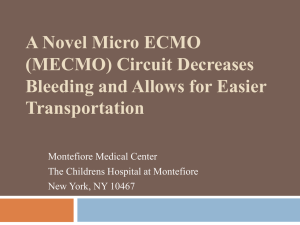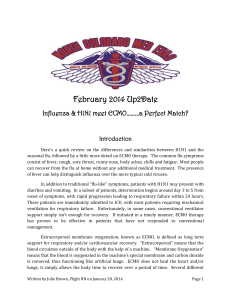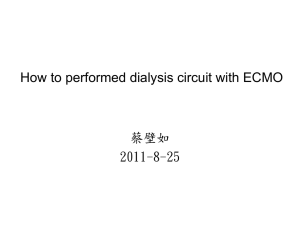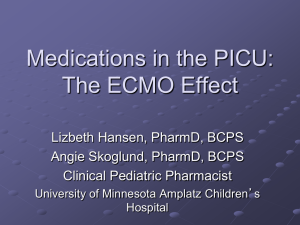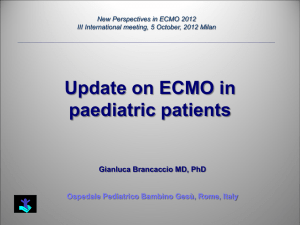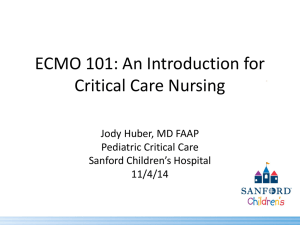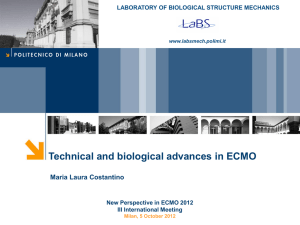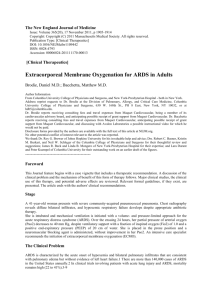Transplantologiya
advertisement
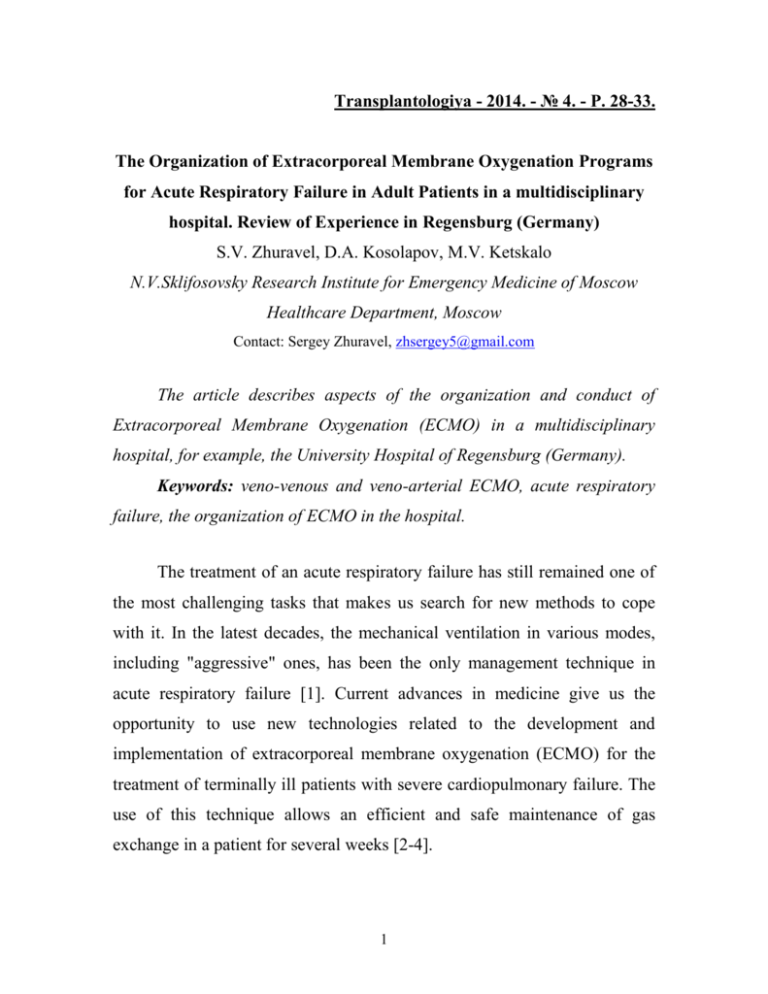
Transplantologiya - 2014. - № 4. - P. 28-33. The Organization of Extracorporeal Membrane Oxygenation Programs for Acute Respiratory Failure in Adult Patients in a multidisciplinary hospital. Review of Experience in Regensburg (Germany) S.V. Zhuravel, D.A. Kosolapov, M.V. Ketskalo N.V.Sklifosovsky Research Institute for Emergency Medicine of Moscow Healthcare Department, Moscow Contact: Sergey Zhuravel, zhsergey5@gmail.com The article describes aspects of the organization and conduct of Extracorporeal Membrane Oxygenation (ECMO) in a multidisciplinary hospital, for example, the University Hospital of Regensburg (Germany). Keywords: veno-venous and veno-arterial ECMO, acute respiratory failure, the organization of ECMO in the hospital. The treatment of an acute respiratory failure has still remained one of the most challenging tasks that makes us search for new methods to cope with it. In the latest decades, the mechanical ventilation in various modes, including "aggressive" ones, has been the only management technique in acute respiratory failure [1]. Current advances in medicine give us the opportunity to use new technologies related to the development and implementation of extracorporeal membrane oxygenation (ECMO) for the treatment of terminally ill patients with severe cardiopulmonary failure. The use of this technique allows an efficient and safe maintenance of gas exchange in a patient for several weeks [2-4]. 1 The purpose of the article was to show the potential of using ECMO for the treatment of acute respiratory failure in a multidisciplinary hospital basing on the experience of Regensburg University Hospital (Bavaria, Germany). The multidisciplinary Regensburg University Hospital was chosen to study a foreign clinical experience with ECMO as the facility taking a leading place in Europe in the implementation and use of this technique to treat various clinical conditions. The Hospital located about 100 km from Munich is a tertiary health care center providing a specialized care for the population of about 2 million inhabitants in the North East Bavaria region. The Hospital counts 20 clinical departments including Cardiac Surgery, Transplantation, Neurosurgery, Trauma Departments. The Hospital has 804 beds specialized in major fields of medicine, including 84 beds (10%) in the Intensive Care Units (ICUs). Annually, about 30,000 in-patients and approximately 100,000 out-patients receive treatment in the Hospital. Regensburg University Hospital has the largest Accident and Emergency (A&E) Centre in the region. Besides modern ambulances and emergency doctors’ cars, the Hospital has two intensive care helicopters well-equipped to provide a critical care during the transportation of severely injuried in traffic accidents, during interhospital transfers, and, when necessary, to use ECMO in the patients with an out-of-hospital cardiac arrest (Fig. 1). There is a constant communication and coordination with the rescue service and other medical institutions. 2 Figure 1. A&E Department of Regensburg University Hospital All ICUs are located on one and the same floor of the Hospital. There are also the Operating Theatre, diagnostic departments with the capacities of radiology, angiography, extracorporeal treatment, and perfusion services. Such arrangement has its undisputed advantages allowing a time reduction in intra-hospital transports, an earlier initiation of care at admission, an easy use of additional implements attached to the medical equipment in a critically ill patient, and also an easier inter-ICU transport of patients and medical equipment. The University Hospital has gained a many-year experience in the treatment of cardiovascular and respiratory failure by using extracorporeal techniques. For example, in the period from 2006 to 2014, 391 veno-arterial ECMOs and 393 veno-venous ECMOs were performed (Fig. 2). A routine use of this efficient innovative technique for the treatment of critical care patients with severe multisystem trauma, those waiting for transplantation, and the patients after cardiopulmonary resuscitation, etc. is impressive. 3 Figure 2. ECMO use in patients with cardiovascular and respiratory failure. ECMO technology is aimed at a life support of critical care patients whose cardiovascular and/or respiratory systemic impairments are still being potentially reversible, but who are failing to respond to a standard therapy. Critical conditions that may bear potential indications to the ECMO use are listed in Table 1. Table 1. Clinical situations that may prompt the ECMO use • Respiratory distress syndrome • Pneumonia (viral, bacterial) Respiratory failure • Aspiration (including drowning) • Upper airway burns • Pulmonary embolism and reperfusion syndrome • Postcardiotomy syndrome Cardiac indications • Myocarditis • Acute myocardial infarction with a cardiogenic 4 shock refractory to a conventional therapy (ruptured mitral chordae tendineae, ventricular septal defect) • Cardiac contusion • Refractory arrhythmia with a fall in a cardiac output • Cardiopulmonary resuscitation • Failure to wean from a cardiopulmonary bypass • Refractory ventricular arrhythmias with a fall in a Critical situations after cardiac surgery in the operating room cardiac output • Failure to maintain adequate hemodynamics, despite the infusion of cardiotonic agents in high doses. • Cardiac arrest non-responding to standard resuscitation efforts As "a bridge" to • Life support of a patient while waiting for a heart transplantation or/and lung transplantation ECMO makes it possible to transport the patient to a specialized clinical facility, to render care to a victim who sustained a severe multisystem trauma (as a result of a road accident), to deliver a patient from the site of an accident to the University Hospital for a specialized medical care, and also to undertake in-hospital transports (Fig.3). 5 Figure 3. Transportation of patients on ECMO At the time of our visit to the clinic, 8 ECMOs of various types were undertaken in the ICUs. The patient population was as follows: 1 patient in condition after coronary artery bypass surgery whose postoperative course was complicated by the respiratory failure developed secondary to pneumonia (Fig. 4); 2 non-surgical patients with a decompensated respiratory failure secondary to a community-acquired pneumonia; 2 other patients who had sustained a severe multisystem trauma complicated by ARDS; 1 patient with multiple etiology pneumonia who received immunosuppression therapy after liver transplantation; 2 patients with decompensated heart failure awaiting for a heart transplantation. 6 Figure 4. ECMO in a patient after a coronary artery bypass surgery who developed a respiratory failure Patients with a respiratory failure had a veno-venous ECMO and those waiting for a heart transplantation had a veno-arterial ECMO (Fig.5, 6). An ECMO procedure was performed as a component in a complex of intensive care measures in ICU beds of relevant departments. In Regensburg University Hospital, each ICU bed is outfitted with a complete set of necessary medical equipment and monitoring devices. Each ICU is arranged to have a laboratory module equipped with blood gas and electrolyte analyzers, and the machine to assess the blood activated clotting time. All the equipment related to the diagnostic and treatment process is connected to a central information system, the access to its data being available from anywhere in the clinic. 7 Figure 5. The scheme of peripheral veno-venous ECMO. Figure 6.The scheme of peripheral veno-arterial ECMO. The indications to ECMO initiation are based on nosological diagnoses and include the development of respiratory and/or cardiac failure (Table.2). Table 2. Veno-venous ECMO use in the period from 2007 to 2014. Diagnosis Number of Sex, Age, ECMO Number of patients male/female years days survivors, (%) Pneumonia, sepsis 214 135/79 8 51 ± 15 13 ± 11 138 (64%) Extrapulmonary sepsis 96 69/27 51 ± 18 8±6 47 (49%) Multisystem trauma 44 40/4 32 ± 15 6±3 29 (72%) Other (heart and lung 39 20/19 51 ± 16 17 ± 14 20 (51%) transplantation) The decision to use the ECMO in a patient is generally taken by a team of doctors that consists of a critical care physician, the attending physician from the pertinent department, and a clinical perfusionist (responsible for a heart-lung machine operation). They discuss a probable course and specific features of the disease, the prognosis, and a potential benefit from ECMO. Should indications to ECMO exist, the doctors make their choice regarding its type, consider the way of the circuit setup and the site of cannula placement. As a rule, in veno-arterial ECMO the cannulas are preferably placed in the femoral vein and artery. A veno-venous access in patients under ECMO treatment was provided by the placement of one cannula via femoral vein into the inferior vena cava, and the other cannula was placed via the internal jugular vein into the superior vena cava. The exceptions were the cases of intraoperative central connection circuit while making cardiac surgery and lung transplantation. We also watched a practical use of the Avalon Elite bicaval dual lumen cannula which was placed in the internal jugular vein and allowed the deoxygenated blood to drain from the inferior vena cava (IVC) and the superior vena cava (SVC); and the oxygenated blood to return from the external pump to the right atrium directed toward the tricuspid valve. The foreign clinical experience implies the allocation of a 24-hour cardiovascular perfusion service having specialists who, besides providing a heart-lung machine management during cardiac surgery, participate in the 9 initiation of ECMO and in a subsequent management and monitoring care of the patient on ECMO. The ECMO specialists are responsible for the equipment preparation, the circuit installation, the set-up and management of monitoring devices. The ECMO equipment with pertinent oxygenators and centrifugal pump heads used in the clinic are from the following manufacturers: Stockert, Maquet and Medos. The central venous access is achieved by cardiovascular surgeons; the peripheral access is the responsibility of the intensive care physicians. ECMO daily monitoring and management is carried out by the physicians and ECMO specialists of the 24-hour duty service. Besides monitoring the standard parameters of hemodynamics, breathing, and electrolyte balance, a special attention, as a rule, is paid to measuring the plasma lactate level, oxygen transmembrane arterial-venous gradient in the ECMO circuit, and activated clotting time. A routine blood sampling is as frequent as 4 times a day, at least. The criteria of a successful and correct ECMO include: the improvement of lactate level over time, return to normal of arterio-venous oxygen difference and other homeostasis parameters, as well as reduced requirements in inotropic support. In some patients, normothermia was maintained using a thermoregulatory device (Hypotherm). ECMO treatment duration varied ranging from 3 to 23 days, as we observed. Weaning from ECMO in the clinic is undertaken by a stepwise approach considering the ECMO method used and the goals to achieve by using it. As a whole, the tactics of weaning off the veno-arterial ECMO is similar to that of weaning from a cardiopulmonary bypass during cardiac surgery. Currently ECMO is the only method that warrants a cardiopulmonary life support for a long time that is essential, for example, for heart and lung transplantation, for a life support in a complicated course of H1N1 virus 10 influenza, in case of a developed acute respiratory distress syndrome (ARDS), in cardiac arrest refractory to resuscitation, as well as for patient's transportation to a specialized clinic anywhere in the world. Currently ECMO is the only method to improve a survival prognosis in patients with severely complicated cardiac and/or pulmonary conditions. The Sklifosovsky Clinical and Research Institute for Emergency Medicine is the leading medical institution in Moscow to provide a specialized care for the patients with severe poytrauma, cardiac pathology, as well as to perform organ transplants. Implementation of ECMO method in the clinical practice may significantly improve the surgical and conservative treatment outcomes in severely ill or traumatized patients. References 1. Gattinoni L., Carlesso E., Cressoni M. Assessing gas exchange in acute lung injury/acute respiratory distress syndrome: diagnostic techniques and prognostic relevance. Curr. Opin. Crit. Care. 2011; 17 (1): 18–23. 2. Bein T., Weber-Carstens S., Goldmann A., [et al.]. Lower tidal volume strategy (≈3 ml/kg) combined with extracorporeal CO2 removal versus ‘conventional’ protective ventilation (6 ml/kg) in severe ARDS. Int. Care Med. 2013; 39 (5): 847–856. 3. Schmid C., Philipp A., Hilker M., [et. al.]. Venous extracorporeal membrane oxygenation for acute lung failure in adults. J. Heart lung transplant. 2012; 31 (1): 9–15. 4. Bein T., Zonies D., Philipp A., [et. al.]. Transportable extracorporeal lung support for rescue of severe respiratory failure in combat casualties. J. Trauma Acute Care Surg. 2012; 73 (6): 1450–1456. 11
